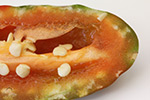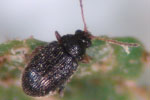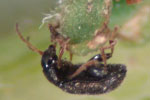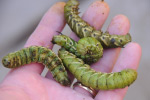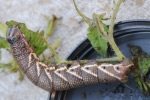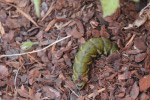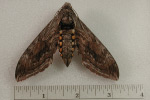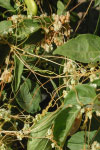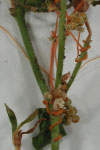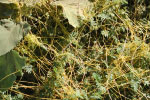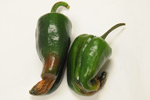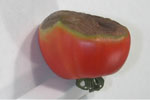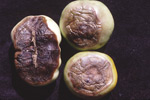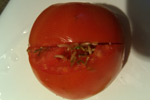Photo Gallery of Vegetable Problems
Pepper
General Pepper Disease and Pest Management |
|||
Diseases |
|||
Insect/Mite Pests |
|||
Parasitic Plants |
|||
Abiotic Problems Common to Pepper |
|||
(Click on photo to enlarge)
General Pepper Disease and Pest Management
Bacterial spot damages Michigan peppers, Spring and summer rains favor disease; coppers can help but not cure bacterial spot on peppers. Mary Hausbeck, Michigan State University.
Growing Peppers in Home Gardens, Extension Bulletin FS220E, by Michael R. Bush, Entomology & Pest Management, Washington State University Extension- Yakima County. Mark D. Heitstuman, County Director, Washington State University Extension- Asotin & Garfield Counties. Lizann Powers-Hammond, Regional Food Specialist, Washington State University Extension- Benton County.
Pepper & Eggplant Disease Guide - A Practical Guide for Seedsmen, Growers and Agricultural Advisors. Published by Seminis Vegetable Seeds, Inc.’s Plant Health Department.
Diseases
Disease: Cucumber
mosaic
Pathogen name: Cucumber mosaic virus (CMV)
Host crops: Numerous plant species (>300) can be infected with
CMV. The virus is vectored by a number of aphids. CMV also can be
seedborne and seed transmitted in pepper.
 |
 |
 |
 |
|
| Foliar symptoms on pepper plants infected with Cucumber mosaic virus. | ||||
| Photo Source: Lindsey du Toit, Washington State University | ||||
Online Resources:
Pepper (Capsicum spp.)-Virus Diseases, PNW Plant Disease Management Handbook, a Pacific Northwest Extension Publication.
Virus Diseases of Pepper, Vegetable MD On-line, Fact Sheet Page: 736.00, T. A. Zitter and D. Florini Dept. of Plant Pathology Cornell University and R. Provvidenti Dept. of Plant Pathology New York State Agricultural Experiment Station, Geneva.
Seed transmission of Cucumber mosaic virus in pepper, Ali A, Kobayashi M, Department of Biological Science, University of Tulsa, published by the National Center for Biotechnology Information, US National Library of Medicine, National Institutes of Health (pubmed.gov).
Cucumber Mosaic Virus - Aphid-Transmitted Cucumovirus, Ray Cerkauskas,
Agriculture and Agri-Food Canada, published by AVRDC – The World
Vegetable Center.
Disease: Gray mold
Pathogen: Botrytis cinerea
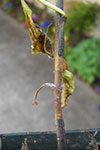 |
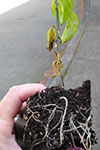 |
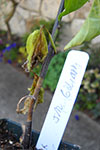 |
Photo Source: Photographer – Sharon Collman |
||
On-Line Resources:
Pepper Diseases: Gray Mold: Botrytis cinerea, AVRDC – The World Vegetable Center.
Insect/Mite Pests
Common name: Broad mites are tiny (0.2
mm-long adult females), oval, light yellow to amber or white or even green
arachnids (so they have eight legs). Male adults are smaller. There are four
life stages: egg, larva, nymph and adult. Eggs are colorless, translucent,
elliptical, about 0.08 mm long, and covered with white tufts on the upper
surface. Young broad mites have only three pairs of legs, are slow moving, and
whitish in color. The quiescent stage is an immobile, engorged larva. Injury to
broad mites can be difficult to diagnose because of how small the pests are and
the locations where they feed on plants. Broad mites typically feed within
growing meristems and require magnification to be seen.
Latin binomial: Polyphagotarsonemus latus (Arachnida:
Acari: Tarsonemidae)
Host crops: Broad mites have a wide host range in tropical
areas and commonly infect plants in greenhouses in temperate and subtropical
areas. Hosts include many perennial and annual plant species, including
ornamentals, citrus, grape, and vegetables such as bean, cucurbits, eggplant,
tomato, pepper, potato, etc. Adults feed on the lower surface of leaves and on
fruit.
| Damage to pepper plants by broad mites. | ||
| Photo Source: Lou Almasi | ||
Online Resources:
Broad Mites in Fruiting Vegetables, Penn State Extension, Plants and Pests, Vegetable, Small Fruit, and Mushroom Production News.Broad Mite, Featured Creatures, Entomology & Nematology, FDACS/DPI, EDIS, University of Florida.
Broad mite is becoming an increasing problem, Dan Gilrein, Greenhouse Management Magazine.
Broad Mite, Entomology: Insects Associated With Vegetable Crops in Georgia: Solanaceous Crops, University of Georgia College of Agricultural and Environmental Sciences.
Broad mite: Not your typical Michigan mite, Michigan State University
Extension News.
Common name: Brown marmorated stink bug (BMSB)
Latin binomial: Halyomorpha halys
Host crops: Very wide host range including Oregon berry, grape, tree fruits, hazelnuts, vegetables including pepper, ornamentals, etc.
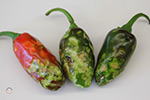 |
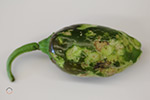 |
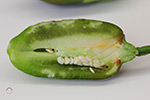 |
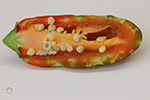 |
| Photo Source: Nik Wimann, Oregon State University | |||
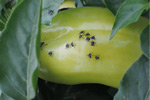 |
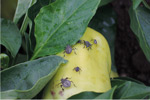 |
| Brown marmorated stink bugs (immatures and adults) feeding on pepper fruit. | |
| Photo Source: Peter Shearer, Oregon State University Entomologist | |
On-Line Resources:
Brown Marmorated Stink Bug in Oregon, Oregon State University
Pest Watch: brown Marmorated Stink Bug, Washington State University Extension Fact Sheet FS0079E
Pest Alert: Brown Marmorated Stink Bug, A quick ID guide from the Oregon Department of Agriculture
See Diseases, pests, and other problems common to many vegetables: Brown marmorated stink bug (BMSB).
Common name: Flea beetle
Latin binomial: Pictured is the western potato flea beetle, Epitrix subcrinita, but the tuber flea beetle, Epitrix tuberis, may also damage foliage.
Host crops: Eggplant, pepper, potato, and tomato.
On-Line Resources:
Potato Flea Beetles: Biology and Control. Washington State University Extension Bulletin 1198E (PDF).
Pacific Northwest Insect Management Handbook. Chapter: Irish Potatoes, Section: Flea Beetle to Grasshopper.
Vegetables: Pepper, Eggplant: Flea beetles. Washington State University Hortsense.
See Diseases, pests, and other problems common to many vegetables: Flea beetle.
Common name (of damaging stage): Tomato hornworm
Latin binomial: Manduca quinquemaculata
Host crops: Pepper, eggplant, potato, and tomato.
On-Line Resources:
Pacific Northwest Insect Management Handbook. Washington State Chapter: Vegetables, Section: Tomato Part2: Fleabeetle to Wireworm.
Vegetables: Tomato: Tomato hornworm. Washington State University Hortsense.
UC Pest Management Guidelines: Tomato Hornworms. UC IPM Online, University of California.
Parasitic Plants
Common name: Field dodder
Latin binomial: Cuscuta spp.
Host Crops: Bean, beet, carrot, onion, pepper, potato, tomato, and many other crops (not only vegetables)
On-Line Resources:
See Diseases, pests, and other problems common to many vegetables: Field dodder.
Abiotic Problems Common to Pepper
Problem: Blossom end rot
Cause: Calcium deficiency resulting from various environmental conditions and management practices, e.g., inadequate Ca in the soil, inconsistent water as a result of alternating wet and dry periods that decrease Ca uptake by plants, and even excellent growing conditions such as a period of very bright sunshine and warm temperatures mid-season.
Crops affected: Tomato, pepper, eggplant, and various cucurbits.
On-Line Resources:
Blossom-End Rot of Tomato, Pepper, and Eggplant. By Miller, S.A., R. C. Rowe, and R. M. Riedel, The Ohio State University Extension Fact Sheet HYG-3117-96.
Blossom end rot: Understanding a perennial problem. Michigan State University Extension.
See Diseases, pests, and other problems common to many vegetables: Blossom end rot of vegetables.
Problem: Vivipary (germination of seeds while still attached to the mother plant)
Crops affected: Solanaceaous vegetables like tomato and pepper.
On-Line Resources:
Effect of potassium nutrition during bell pepper seed development on vivipary and endogenous levels of abscisic acid (ABA).. By Marrush, M., M. Yamaguchi and M. E. Saltveit. 1998. J. Amer. Soc. Hort. Sci. 123(5):925–930.
Physiological and Nutrient Disorders. University of Kentucky Vegetable Integrated Pest Management Program. Vegetable Manuals.
See Diseases, pests, and other problems common to many vegetables: Vivipary.
Our pages provide links to external sites for the convenience of users. WSU Extension does not manage these external sites, nor does Extension review, control, or take responsibility for the content of these sites. These external sites do not implicitly or explicitly represent official positions and policies of WSU Extension.

